Ethical Consumerism: Attitudes, Reality, and Behavioral Gap Analysis
VerifiedAdded on 2022/01/27
|75
|22023
|51
Report
AI Summary
This report provides a comprehensive analysis of ethical consumerism, examining consumer attitudes, the reality of ethical choices, and the behavioral gap that exists between them. The report begins with an overview of ethical consumption, defining it as the purchase of products made with ethical and moral principles, and exploring its history and evolution. It then delves into the conceptualization of consumer ethics, factors influencing ethical consumption, and the role of religiosity and ethical reasoning in consumer decision-making. The report also reviews the impact of ethical marketing, consumer-brand relationships, and the evolution of technologies in consumer ethical decision-making. Furthermore, it explores the significance of ethical consumerism as an integral part of business ethics and discusses the factors that influence consumer choices. The methodology section outlines the research philosophy, approach, strategies, and data collection methods used in the study. The report concludes with a discussion of the findings, limitations, and ethical considerations of the research, providing valuable insights into the dynamics of ethical consumerism and its implications for businesses and consumers alike.

ETHICAL CONSUMERISM: ATTITUDE, REALITY AND THE BEHAVIOURAL GAP
[Student Name]
[Institution Name]
[Student Name]
[Institution Name]
Paraphrase This Document
Need a fresh take? Get an instant paraphrase of this document with our AI Paraphraser
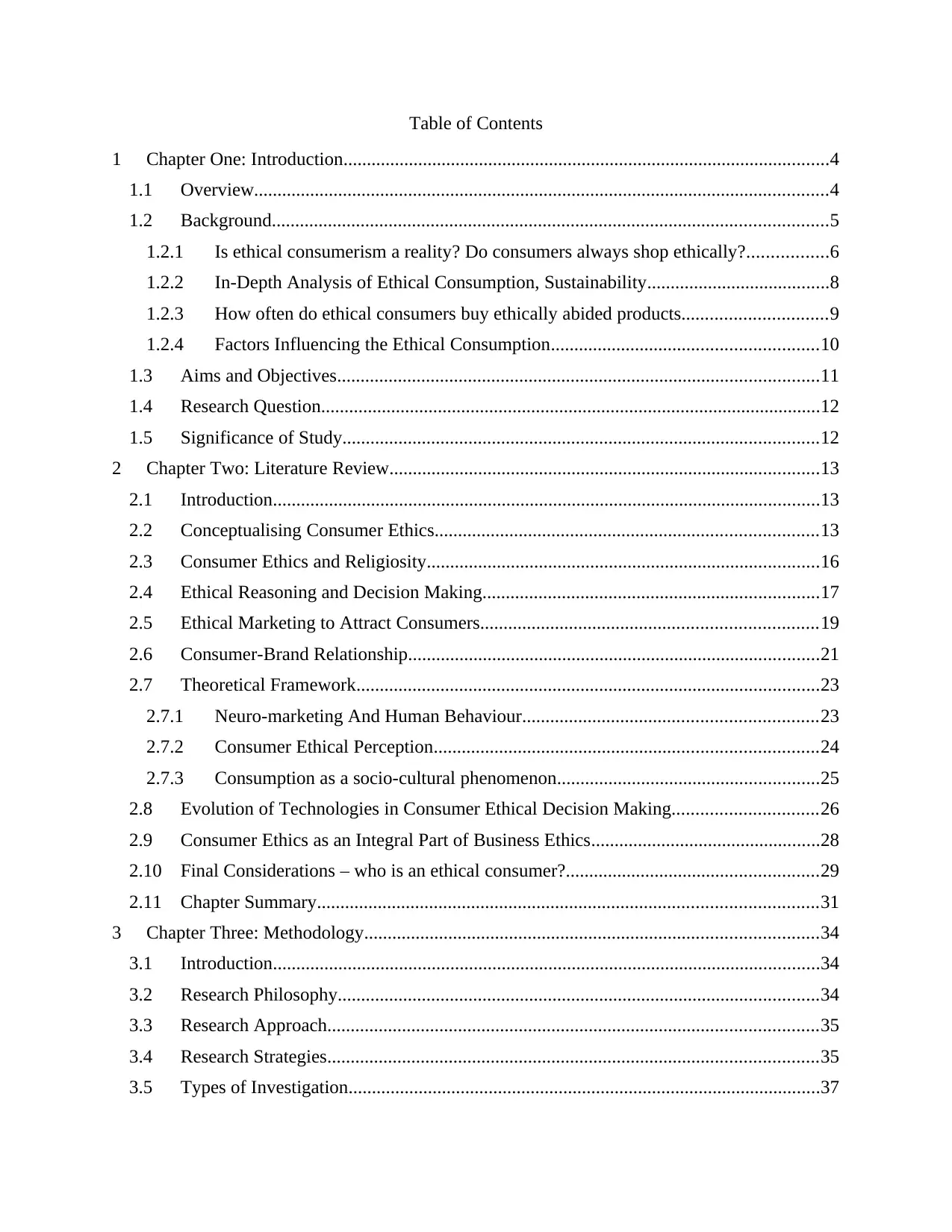
Table of Contents
1 Chapter One: Introduction........................................................................................................4
1.1 Overview...........................................................................................................................4
1.2 Background.......................................................................................................................5
1.2.1 Is ethical consumerism a reality? Do consumers always shop ethically?.................6
1.2.2 In-Depth Analysis of Ethical Consumption, Sustainability.......................................8
1.2.3 How often do ethical consumers buy ethically abided products...............................9
1.2.4 Factors Influencing the Ethical Consumption.........................................................10
1.3 Aims and Objectives.......................................................................................................11
1.4 Research Question...........................................................................................................12
1.5 Significance of Study......................................................................................................12
2 Chapter Two: Literature Review............................................................................................13
2.1 Introduction.....................................................................................................................13
2.2 Conceptualising Consumer Ethics..................................................................................13
2.3 Consumer Ethics and Religiosity....................................................................................16
2.4 Ethical Reasoning and Decision Making........................................................................17
2.5 Ethical Marketing to Attract Consumers........................................................................19
2.6 Consumer-Brand Relationship........................................................................................21
2.7 Theoretical Framework...................................................................................................23
2.7.1 Neuro-marketing And Human Behaviour...............................................................23
2.7.2 Consumer Ethical Perception..................................................................................24
2.7.3 Consumption as a socio-cultural phenomenon........................................................25
2.8 Evolution of Technologies in Consumer Ethical Decision Making...............................26
2.9 Consumer Ethics as an Integral Part of Business Ethics.................................................28
2.10 Final Considerations – who is an ethical consumer?......................................................29
2.11 Chapter Summary...........................................................................................................31
3 Chapter Three: Methodology.................................................................................................34
3.1 Introduction.....................................................................................................................34
3.2 Research Philosophy.......................................................................................................34
3.3 Research Approach.........................................................................................................35
3.4 Research Strategies.........................................................................................................35
3.5 Types of Investigation.....................................................................................................37
1 Chapter One: Introduction........................................................................................................4
1.1 Overview...........................................................................................................................4
1.2 Background.......................................................................................................................5
1.2.1 Is ethical consumerism a reality? Do consumers always shop ethically?.................6
1.2.2 In-Depth Analysis of Ethical Consumption, Sustainability.......................................8
1.2.3 How often do ethical consumers buy ethically abided products...............................9
1.2.4 Factors Influencing the Ethical Consumption.........................................................10
1.3 Aims and Objectives.......................................................................................................11
1.4 Research Question...........................................................................................................12
1.5 Significance of Study......................................................................................................12
2 Chapter Two: Literature Review............................................................................................13
2.1 Introduction.....................................................................................................................13
2.2 Conceptualising Consumer Ethics..................................................................................13
2.3 Consumer Ethics and Religiosity....................................................................................16
2.4 Ethical Reasoning and Decision Making........................................................................17
2.5 Ethical Marketing to Attract Consumers........................................................................19
2.6 Consumer-Brand Relationship........................................................................................21
2.7 Theoretical Framework...................................................................................................23
2.7.1 Neuro-marketing And Human Behaviour...............................................................23
2.7.2 Consumer Ethical Perception..................................................................................24
2.7.3 Consumption as a socio-cultural phenomenon........................................................25
2.8 Evolution of Technologies in Consumer Ethical Decision Making...............................26
2.9 Consumer Ethics as an Integral Part of Business Ethics.................................................28
2.10 Final Considerations – who is an ethical consumer?......................................................29
2.11 Chapter Summary...........................................................................................................31
3 Chapter Three: Methodology.................................................................................................34
3.1 Introduction.....................................................................................................................34
3.2 Research Philosophy.......................................................................................................34
3.3 Research Approach.........................................................................................................35
3.4 Research Strategies.........................................................................................................35
3.5 Types of Investigation.....................................................................................................37
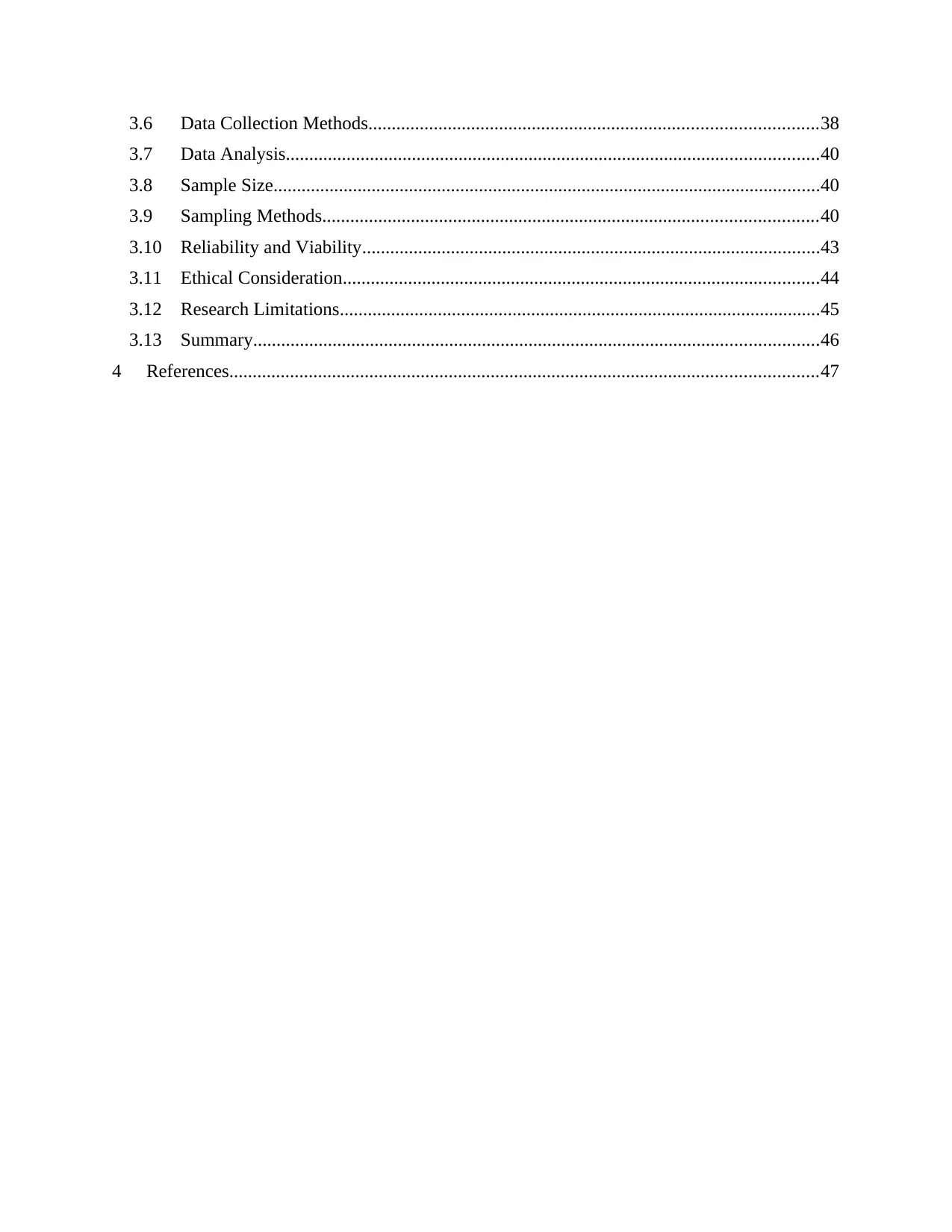
3.6 Data Collection Methods................................................................................................38
3.7 Data Analysis..................................................................................................................40
3.8 Sample Size.....................................................................................................................40
3.9 Sampling Methods..........................................................................................................40
3.10 Reliability and Viability..................................................................................................43
3.11 Ethical Consideration......................................................................................................44
3.12 Research Limitations.......................................................................................................45
3.13 Summary.........................................................................................................................46
4 References..............................................................................................................................47
3.7 Data Analysis..................................................................................................................40
3.8 Sample Size.....................................................................................................................40
3.9 Sampling Methods..........................................................................................................40
3.10 Reliability and Viability..................................................................................................43
3.11 Ethical Consideration......................................................................................................44
3.12 Research Limitations.......................................................................................................45
3.13 Summary.........................................................................................................................46
4 References..............................................................................................................................47
⊘ This is a preview!⊘
Do you want full access?
Subscribe today to unlock all pages.

Trusted by 1+ million students worldwide

1 CHAPTER ONE: INTRODUCTION
1.1 Overview
Notably, the concept of ethical consumption and/or ethical consumerism is considered the
overall consumer behaviour to buy products, which are produced using a code of ethics and
moral principles. Moreover, this term mainly covers all periods of the life cycle of consumption
from purchase to use and disposal of a product (Gummerus, Liljander, and Sihlman, 2017). The
idea of “ethical” shopping is based on how people prefer buying products, which are
manufactured while giving preference to worldly principles and moral values. For example, it
has been appraised that many people today prefer buying electric cars over conventional motor
vehicles as electric cars are although more expensive. Still, they are eco-friendly, due to which
they are not perilous to environmental sustainability. In a similar way, many individuals also
prefer buying fake leather and fake fur apparel to reduce the extent of animal hunting for the
sake of business. Nonetheless, the notion of eating vegetables instead of meat and the trend of
buying organic cosmetics, which is not tested on animals, has turned out to be a major trend
across the world. In this way, it has become evident
An investigation led by Yoon (2019) further proclaimed that ethical consumption has
turned out to be a social phenomenon that reflects people’s growing concerns of people in
developed countries about the planet’s environmental and social problems. The phenomenon
finds its expression in the increased interest of buyers in the origin and composition of the
purchased product or service, environmental and social conditions of production, social
responsibility of the producer’s company, methods of disposal of goods, and so on (Zollo, 2020).
Ethical consumption is expressed in the deliberate selection of goods and services that have been
produced, processed and delivered in an ethical manner, that is, with minimal harm to people,
1.1 Overview
Notably, the concept of ethical consumption and/or ethical consumerism is considered the
overall consumer behaviour to buy products, which are produced using a code of ethics and
moral principles. Moreover, this term mainly covers all periods of the life cycle of consumption
from purchase to use and disposal of a product (Gummerus, Liljander, and Sihlman, 2017). The
idea of “ethical” shopping is based on how people prefer buying products, which are
manufactured while giving preference to worldly principles and moral values. For example, it
has been appraised that many people today prefer buying electric cars over conventional motor
vehicles as electric cars are although more expensive. Still, they are eco-friendly, due to which
they are not perilous to environmental sustainability. In a similar way, many individuals also
prefer buying fake leather and fake fur apparel to reduce the extent of animal hunting for the
sake of business. Nonetheless, the notion of eating vegetables instead of meat and the trend of
buying organic cosmetics, which is not tested on animals, has turned out to be a major trend
across the world. In this way, it has become evident
An investigation led by Yoon (2019) further proclaimed that ethical consumption has
turned out to be a social phenomenon that reflects people’s growing concerns of people in
developed countries about the planet’s environmental and social problems. The phenomenon
finds its expression in the increased interest of buyers in the origin and composition of the
purchased product or service, environmental and social conditions of production, social
responsibility of the producer’s company, methods of disposal of goods, and so on (Zollo, 2020).
Ethical consumption is expressed in the deliberate selection of goods and services that have been
produced, processed and delivered in an ethical manner, that is, with minimal harm to people,
Paraphrase This Document
Need a fresh take? Get an instant paraphrase of this document with our AI Paraphraser
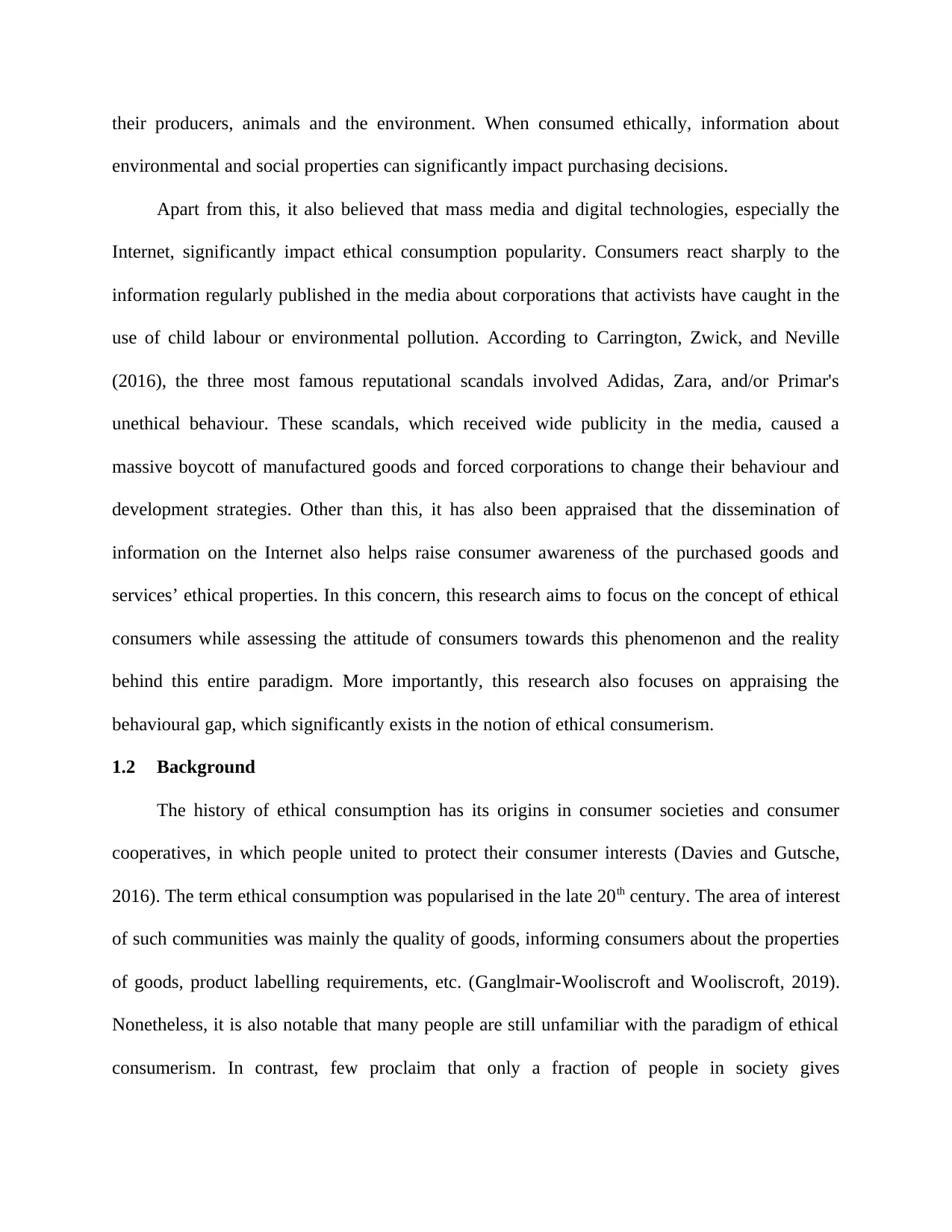
their producers, animals and the environment. When consumed ethically, information about
environmental and social properties can significantly impact purchasing decisions.
Apart from this, it also believed that mass media and digital technologies, especially the
Internet, significantly impact ethical consumption popularity. Consumers react sharply to the
information regularly published in the media about corporations that activists have caught in the
use of child labour or environmental pollution. According to Carrington, Zwick, and Neville
(2016), the three most famous reputational scandals involved Adidas, Zara, and/or Primar's
unethical behaviour. These scandals, which received wide publicity in the media, caused a
massive boycott of manufactured goods and forced corporations to change their behaviour and
development strategies. Other than this, it has also been appraised that the dissemination of
information on the Internet also helps raise consumer awareness of the purchased goods and
services’ ethical properties. In this concern, this research aims to focus on the concept of ethical
consumers while assessing the attitude of consumers towards this phenomenon and the reality
behind this entire paradigm. More importantly, this research also focuses on appraising the
behavioural gap, which significantly exists in the notion of ethical consumerism.
1.2 Background
The history of ethical consumption has its origins in consumer societies and consumer
cooperatives, in which people united to protect their consumer interests (Davies and Gutsche,
2016). The term ethical consumption was popularised in the late 20th century. The area of interest
of such communities was mainly the quality of goods, informing consumers about the properties
of goods, product labelling requirements, etc. (Ganglmair-Wooliscroft and Wooliscroft, 2019).
Nonetheless, it is also notable that many people are still unfamiliar with the paradigm of ethical
consumerism. In contrast, few proclaim that only a fraction of people in society gives
environmental and social properties can significantly impact purchasing decisions.
Apart from this, it also believed that mass media and digital technologies, especially the
Internet, significantly impact ethical consumption popularity. Consumers react sharply to the
information regularly published in the media about corporations that activists have caught in the
use of child labour or environmental pollution. According to Carrington, Zwick, and Neville
(2016), the three most famous reputational scandals involved Adidas, Zara, and/or Primar's
unethical behaviour. These scandals, which received wide publicity in the media, caused a
massive boycott of manufactured goods and forced corporations to change their behaviour and
development strategies. Other than this, it has also been appraised that the dissemination of
information on the Internet also helps raise consumer awareness of the purchased goods and
services’ ethical properties. In this concern, this research aims to focus on the concept of ethical
consumers while assessing the attitude of consumers towards this phenomenon and the reality
behind this entire paradigm. More importantly, this research also focuses on appraising the
behavioural gap, which significantly exists in the notion of ethical consumerism.
1.2 Background
The history of ethical consumption has its origins in consumer societies and consumer
cooperatives, in which people united to protect their consumer interests (Davies and Gutsche,
2016). The term ethical consumption was popularised in the late 20th century. The area of interest
of such communities was mainly the quality of goods, informing consumers about the properties
of goods, product labelling requirements, etc. (Ganglmair-Wooliscroft and Wooliscroft, 2019).
Nonetheless, it is also notable that many people are still unfamiliar with the paradigm of ethical
consumerism. In contrast, few proclaim that only a fraction of people in society gives

consideration to ethical consumption. In this regard, this section of the research will appraise the
entire phenomenon of ethical consumption from three different lenses based on the paradigm of
realism, sustainability, and influence of ethical consumption in society.
1.2.1 Is ethical consumerism a reality? Do consumers always shop ethically?
Since the late 1990s, activism against transnational corporations has begun to escalate
globally. This phenomenon is based on the significance of the impact that such companies’
business practices have on the interests of millions of people, even those who do not work for
these companies and are not consumers of the goods. There is a heightened interest in the
corporate social responsibility of companies in society (Kushwah, Dhir, and Sagar, 2019).
The early 21st century has been marked by an intensification in community activists’
attention to the observance of the rights of workers who produce goods for multinational
corporations in developing countries. Moreover, many companies or their contractors have been
convicted of exploiting labour in sweatshops, using child labour, and harsh working conditions.
The consumer boycott was announced to such companies, thanks to which, in many cases, the
working conditions of the workers were improved (Zollo, et al., 2018).
Recently, a movement of “green consumption” has become prevalent, which is mainly
originated on the impact of the production and use of goods on the environment. This type of
activism consists of selecting goods, the production of which has a minimal impact on the state
of the environment (Zollo, et al., 2018)
In The Global Market as an Ethical System, philosopher and ethicist Yoon (2019)
revealed that every purchase decision contains a moral choice. In this way, it can be articulated
that ethical consumption mainly extends both to the choice of goods and services and to the
choice of companies that provide them. Depending on the buyer’s moral principles, he may pay
entire phenomenon of ethical consumption from three different lenses based on the paradigm of
realism, sustainability, and influence of ethical consumption in society.
1.2.1 Is ethical consumerism a reality? Do consumers always shop ethically?
Since the late 1990s, activism against transnational corporations has begun to escalate
globally. This phenomenon is based on the significance of the impact that such companies’
business practices have on the interests of millions of people, even those who do not work for
these companies and are not consumers of the goods. There is a heightened interest in the
corporate social responsibility of companies in society (Kushwah, Dhir, and Sagar, 2019).
The early 21st century has been marked by an intensification in community activists’
attention to the observance of the rights of workers who produce goods for multinational
corporations in developing countries. Moreover, many companies or their contractors have been
convicted of exploiting labour in sweatshops, using child labour, and harsh working conditions.
The consumer boycott was announced to such companies, thanks to which, in many cases, the
working conditions of the workers were improved (Zollo, et al., 2018).
Recently, a movement of “green consumption” has become prevalent, which is mainly
originated on the impact of the production and use of goods on the environment. This type of
activism consists of selecting goods, the production of which has a minimal impact on the state
of the environment (Zollo, et al., 2018)
In The Global Market as an Ethical System, philosopher and ethicist Yoon (2019)
revealed that every purchase decision contains a moral choice. In this way, it can be articulated
that ethical consumption mainly extends both to the choice of goods and services and to the
choice of companies that provide them. Depending on the buyer’s moral principles, he may pay
⊘ This is a preview!⊘
Do you want full access?
Subscribe today to unlock all pages.

Trusted by 1+ million students worldwide
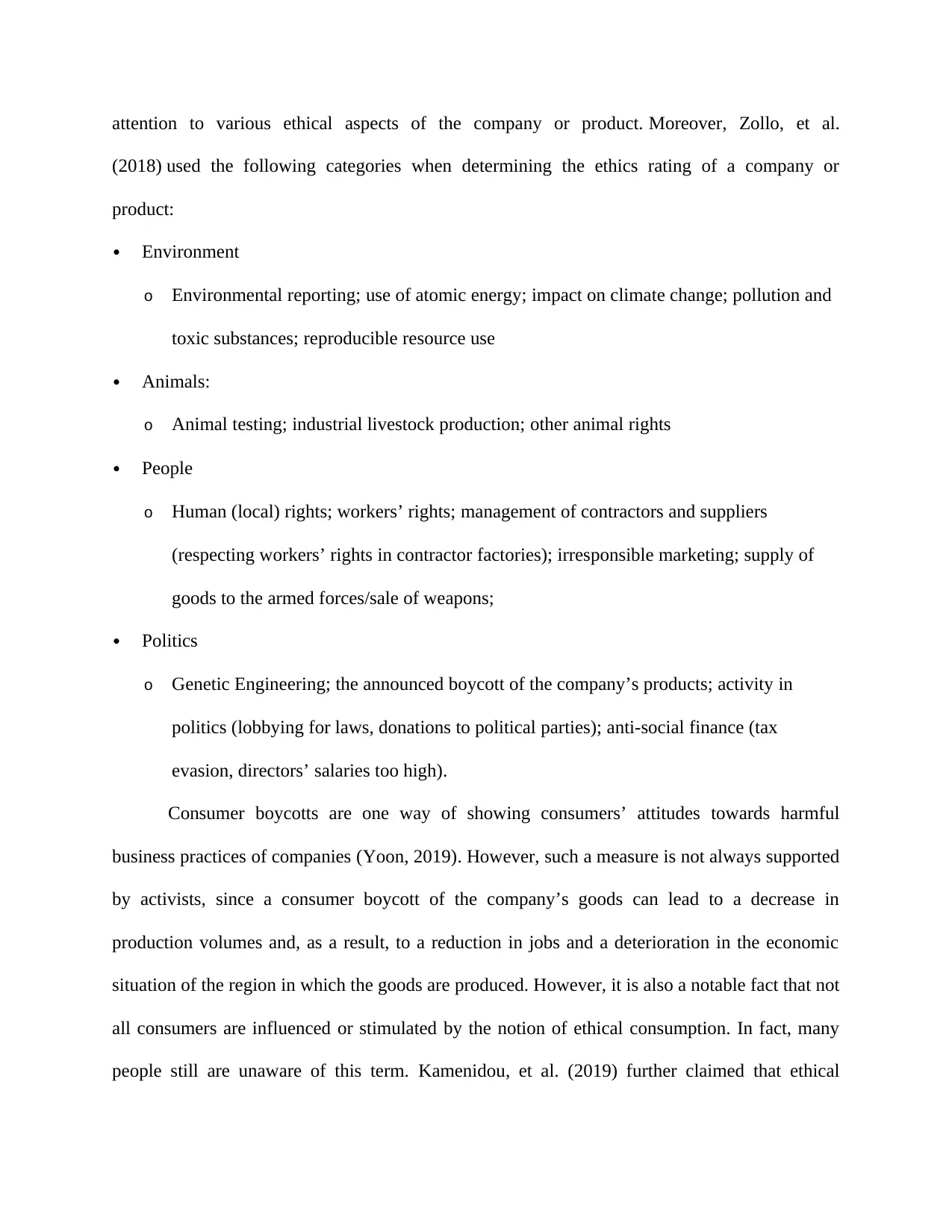
attention to various ethical aspects of the company or product. Moreover, Zollo, et al.
(2018) used the following categories when determining the ethics rating of a company or
product:
Environment
o Environmental reporting; use of atomic energy; impact on climate change; pollution and
toxic substances; reproducible resource use
Animals:
o Animal testing; industrial livestock production; other animal rights
People
o Human (local) rights; workers’ rights; management of contractors and suppliers
(respecting workers’ rights in contractor factories); irresponsible marketing; supply of
goods to the armed forces/sale of weapons;
Politics
o Genetic Engineering; the announced boycott of the company’s products; activity in
politics (lobbying for laws, donations to political parties); anti-social finance (tax
evasion, directors’ salaries too high).
Consumer boycotts are one way of showing consumers’ attitudes towards harmful
business practices of companies (Yoon, 2019). However, such a measure is not always supported
by activists, since a consumer boycott of the company’s goods can lead to a decrease in
production volumes and, as a result, to a reduction in jobs and a deterioration in the economic
situation of the region in which the goods are produced. However, it is also a notable fact that not
all consumers are influenced or stimulated by the notion of ethical consumption. In fact, many
people still are unaware of this term. Kamenidou, et al. (2019) further claimed that ethical
(2018) used the following categories when determining the ethics rating of a company or
product:
Environment
o Environmental reporting; use of atomic energy; impact on climate change; pollution and
toxic substances; reproducible resource use
Animals:
o Animal testing; industrial livestock production; other animal rights
People
o Human (local) rights; workers’ rights; management of contractors and suppliers
(respecting workers’ rights in contractor factories); irresponsible marketing; supply of
goods to the armed forces/sale of weapons;
Politics
o Genetic Engineering; the announced boycott of the company’s products; activity in
politics (lobbying for laws, donations to political parties); anti-social finance (tax
evasion, directors’ salaries too high).
Consumer boycotts are one way of showing consumers’ attitudes towards harmful
business practices of companies (Yoon, 2019). However, such a measure is not always supported
by activists, since a consumer boycott of the company’s goods can lead to a decrease in
production volumes and, as a result, to a reduction in jobs and a deterioration in the economic
situation of the region in which the goods are produced. However, it is also a notable fact that not
all consumers are influenced or stimulated by the notion of ethical consumption. In fact, many
people still are unaware of this term. Kamenidou, et al. (2019) further claimed that ethical
Paraphrase This Document
Need a fresh take? Get an instant paraphrase of this document with our AI Paraphraser
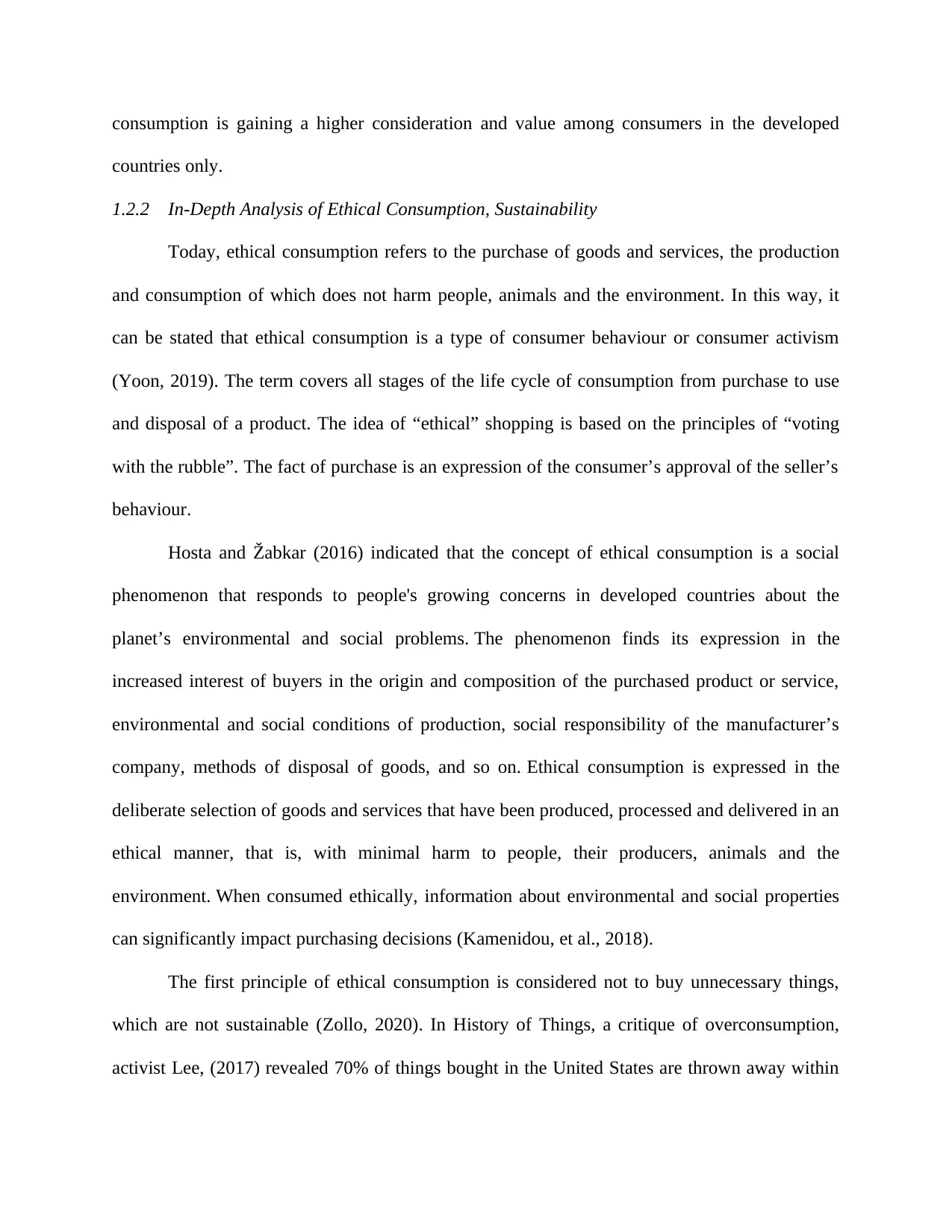
consumption is gaining a higher consideration and value among consumers in the developed
countries only.
1.2.2 In-Depth Analysis of Ethical Consumption, Sustainability
Today, ethical consumption refers to the purchase of goods and services, the production
and consumption of which does not harm people, animals and the environment. In this way, it
can be stated that ethical consumption is a type of consumer behaviour or consumer activism
(Yoon, 2019). The term covers all stages of the life cycle of consumption from purchase to use
and disposal of a product. The idea of “ethical” shopping is based on the principles of “voting
with the rubble”. The fact of purchase is an expression of the consumer’s approval of the seller’s
behaviour.
Hosta and Žabkar (2016) indicated that the concept of ethical consumption is a social
phenomenon that responds to people's growing concerns in developed countries about the
planet’s environmental and social problems. The phenomenon finds its expression in the
increased interest of buyers in the origin and composition of the purchased product or service,
environmental and social conditions of production, social responsibility of the manufacturer’s
company, methods of disposal of goods, and so on. Ethical consumption is expressed in the
deliberate selection of goods and services that have been produced, processed and delivered in an
ethical manner, that is, with minimal harm to people, their producers, animals and the
environment. When consumed ethically, information about environmental and social properties
can significantly impact purchasing decisions (Kamenidou, et al., 2018).
The first principle of ethical consumption is considered not to buy unnecessary things,
which are not sustainable (Zollo, 2020). In History of Things, a critique of overconsumption,
activist Lee, (2017) revealed 70% of things bought in the United States are thrown away within
countries only.
1.2.2 In-Depth Analysis of Ethical Consumption, Sustainability
Today, ethical consumption refers to the purchase of goods and services, the production
and consumption of which does not harm people, animals and the environment. In this way, it
can be stated that ethical consumption is a type of consumer behaviour or consumer activism
(Yoon, 2019). The term covers all stages of the life cycle of consumption from purchase to use
and disposal of a product. The idea of “ethical” shopping is based on the principles of “voting
with the rubble”. The fact of purchase is an expression of the consumer’s approval of the seller’s
behaviour.
Hosta and Žabkar (2016) indicated that the concept of ethical consumption is a social
phenomenon that responds to people's growing concerns in developed countries about the
planet’s environmental and social problems. The phenomenon finds its expression in the
increased interest of buyers in the origin and composition of the purchased product or service,
environmental and social conditions of production, social responsibility of the manufacturer’s
company, methods of disposal of goods, and so on. Ethical consumption is expressed in the
deliberate selection of goods and services that have been produced, processed and delivered in an
ethical manner, that is, with minimal harm to people, their producers, animals and the
environment. When consumed ethically, information about environmental and social properties
can significantly impact purchasing decisions (Kamenidou, et al., 2018).
The first principle of ethical consumption is considered not to buy unnecessary things,
which are not sustainable (Zollo, 2020). In History of Things, a critique of overconsumption,
activist Lee, (2017) revealed 70% of things bought in the United States are thrown away within
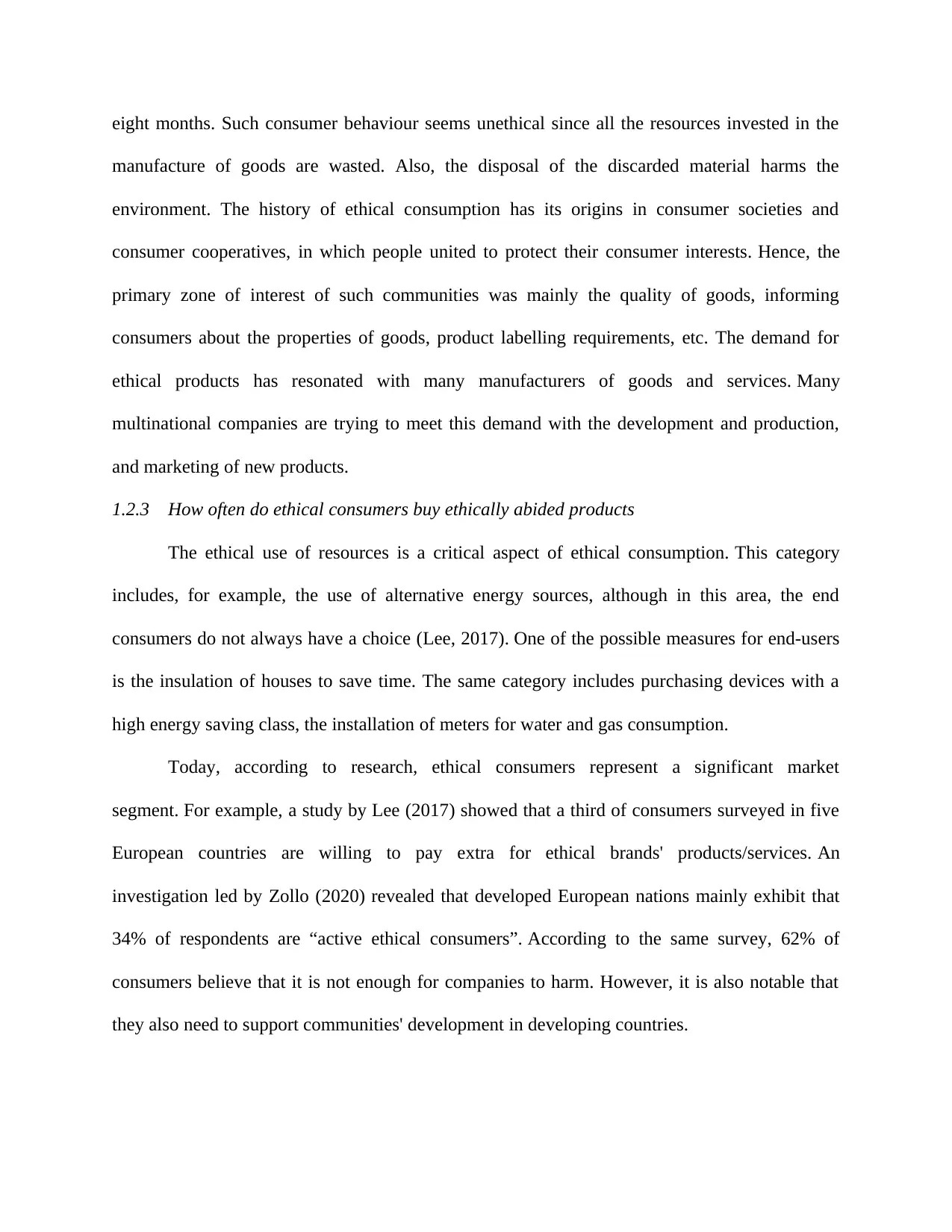
eight months. Such consumer behaviour seems unethical since all the resources invested in the
manufacture of goods are wasted. Also, the disposal of the discarded material harms the
environment. The history of ethical consumption has its origins in consumer societies and
consumer cooperatives, in which people united to protect their consumer interests. Hence, the
primary zone of interest of such communities was mainly the quality of goods, informing
consumers about the properties of goods, product labelling requirements, etc. The demand for
ethical products has resonated with many manufacturers of goods and services. Many
multinational companies are trying to meet this demand with the development and production,
and marketing of new products.
1.2.3 How often do ethical consumers buy ethically abided products
The ethical use of resources is a critical aspect of ethical consumption. This category
includes, for example, the use of alternative energy sources, although in this area, the end
consumers do not always have a choice (Lee, 2017). One of the possible measures for end-users
is the insulation of houses to save time. The same category includes purchasing devices with a
high energy saving class, the installation of meters for water and gas consumption.
Today, according to research, ethical consumers represent a significant market
segment. For example, a study by Lee (2017) showed that a third of consumers surveyed in five
European countries are willing to pay extra for ethical brands' products/services. An
investigation led by Zollo (2020) revealed that developed European nations mainly exhibit that
34% of respondents are “active ethical consumers”. According to the same survey, 62% of
consumers believe that it is not enough for companies to harm. However, it is also notable that
they also need to support communities' development in developing countries.
manufacture of goods are wasted. Also, the disposal of the discarded material harms the
environment. The history of ethical consumption has its origins in consumer societies and
consumer cooperatives, in which people united to protect their consumer interests. Hence, the
primary zone of interest of such communities was mainly the quality of goods, informing
consumers about the properties of goods, product labelling requirements, etc. The demand for
ethical products has resonated with many manufacturers of goods and services. Many
multinational companies are trying to meet this demand with the development and production,
and marketing of new products.
1.2.3 How often do ethical consumers buy ethically abided products
The ethical use of resources is a critical aspect of ethical consumption. This category
includes, for example, the use of alternative energy sources, although in this area, the end
consumers do not always have a choice (Lee, 2017). One of the possible measures for end-users
is the insulation of houses to save time. The same category includes purchasing devices with a
high energy saving class, the installation of meters for water and gas consumption.
Today, according to research, ethical consumers represent a significant market
segment. For example, a study by Lee (2017) showed that a third of consumers surveyed in five
European countries are willing to pay extra for ethical brands' products/services. An
investigation led by Zollo (2020) revealed that developed European nations mainly exhibit that
34% of respondents are “active ethical consumers”. According to the same survey, 62% of
consumers believe that it is not enough for companies to harm. However, it is also notable that
they also need to support communities' development in developing countries.
⊘ This is a preview!⊘
Do you want full access?
Subscribe today to unlock all pages.

Trusted by 1+ million students worldwide
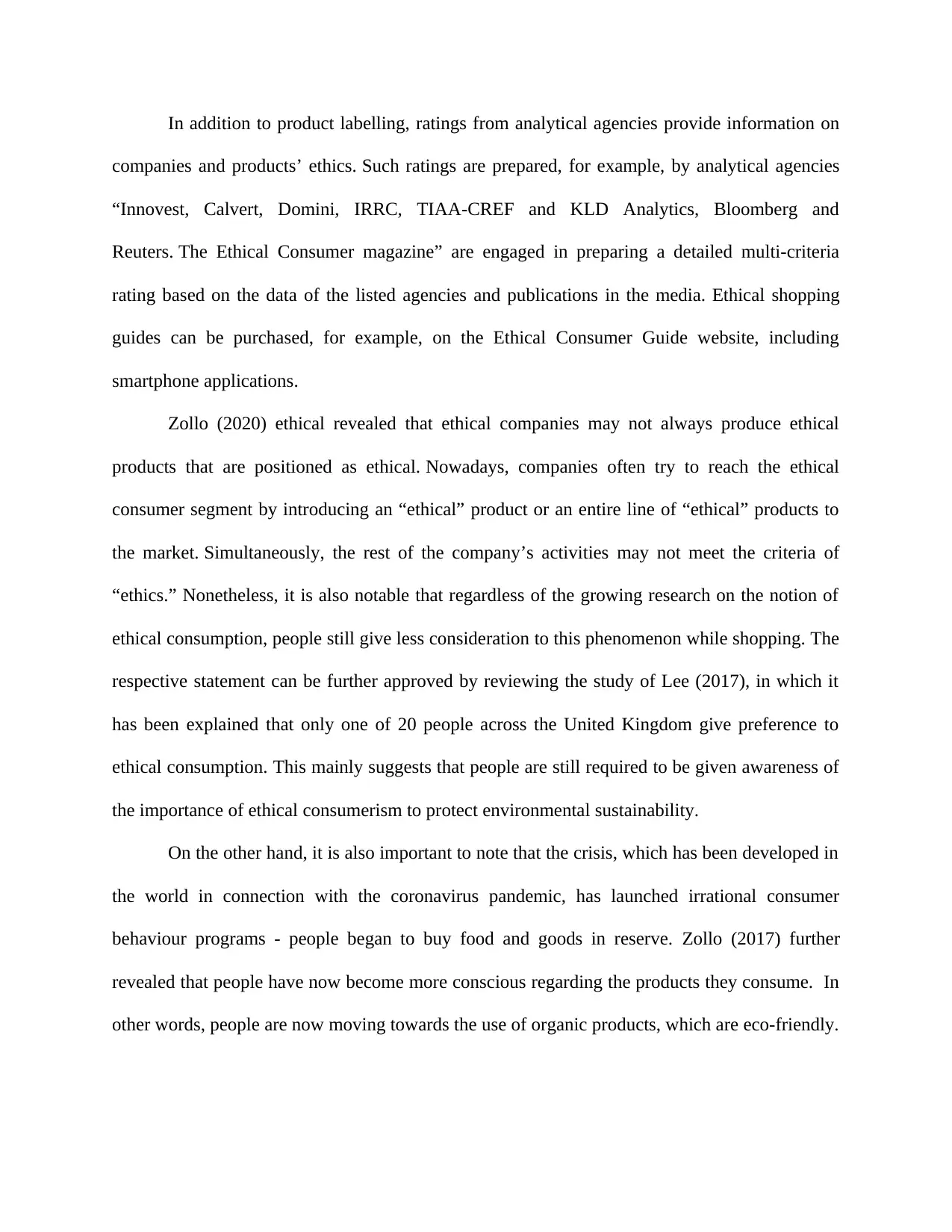
In addition to product labelling, ratings from analytical agencies provide information on
companies and products’ ethics. Such ratings are prepared, for example, by analytical agencies
“Innovest, Calvert, Domini, IRRC, TIAA-CREF and KLD Analytics, Bloomberg and
Reuters. The Ethical Consumer magazine” are engaged in preparing a detailed multi-criteria
rating based on the data of the listed agencies and publications in the media. Ethical shopping
guides can be purchased, for example, on the Ethical Consumer Guide website, including
smartphone applications.
Zollo (2020) ethical revealed that ethical companies may not always produce ethical
products that are positioned as ethical. Nowadays, companies often try to reach the ethical
consumer segment by introducing an “ethical” product or an entire line of “ethical” products to
the market. Simultaneously, the rest of the company’s activities may not meet the criteria of
“ethics.” Nonetheless, it is also notable that regardless of the growing research on the notion of
ethical consumption, people still give less consideration to this phenomenon while shopping. The
respective statement can be further approved by reviewing the study of Lee (2017), in which it
has been explained that only one of 20 people across the United Kingdom give preference to
ethical consumption. This mainly suggests that people are still required to be given awareness of
the importance of ethical consumerism to protect environmental sustainability.
On the other hand, it is also important to note that the crisis, which has been developed in
the world in connection with the coronavirus pandemic, has launched irrational consumer
behaviour programs - people began to buy food and goods in reserve. Zollo (2017) further
revealed that people have now become more conscious regarding the products they consume. In
other words, people are now moving towards the use of organic products, which are eco-friendly.
companies and products’ ethics. Such ratings are prepared, for example, by analytical agencies
“Innovest, Calvert, Domini, IRRC, TIAA-CREF and KLD Analytics, Bloomberg and
Reuters. The Ethical Consumer magazine” are engaged in preparing a detailed multi-criteria
rating based on the data of the listed agencies and publications in the media. Ethical shopping
guides can be purchased, for example, on the Ethical Consumer Guide website, including
smartphone applications.
Zollo (2020) ethical revealed that ethical companies may not always produce ethical
products that are positioned as ethical. Nowadays, companies often try to reach the ethical
consumer segment by introducing an “ethical” product or an entire line of “ethical” products to
the market. Simultaneously, the rest of the company’s activities may not meet the criteria of
“ethics.” Nonetheless, it is also notable that regardless of the growing research on the notion of
ethical consumption, people still give less consideration to this phenomenon while shopping. The
respective statement can be further approved by reviewing the study of Lee (2017), in which it
has been explained that only one of 20 people across the United Kingdom give preference to
ethical consumption. This mainly suggests that people are still required to be given awareness of
the importance of ethical consumerism to protect environmental sustainability.
On the other hand, it is also important to note that the crisis, which has been developed in
the world in connection with the coronavirus pandemic, has launched irrational consumer
behaviour programs - people began to buy food and goods in reserve. Zollo (2017) further
revealed that people have now become more conscious regarding the products they consume. In
other words, people are now moving towards the use of organic products, which are eco-friendly.
Paraphrase This Document
Need a fresh take? Get an instant paraphrase of this document with our AI Paraphraser
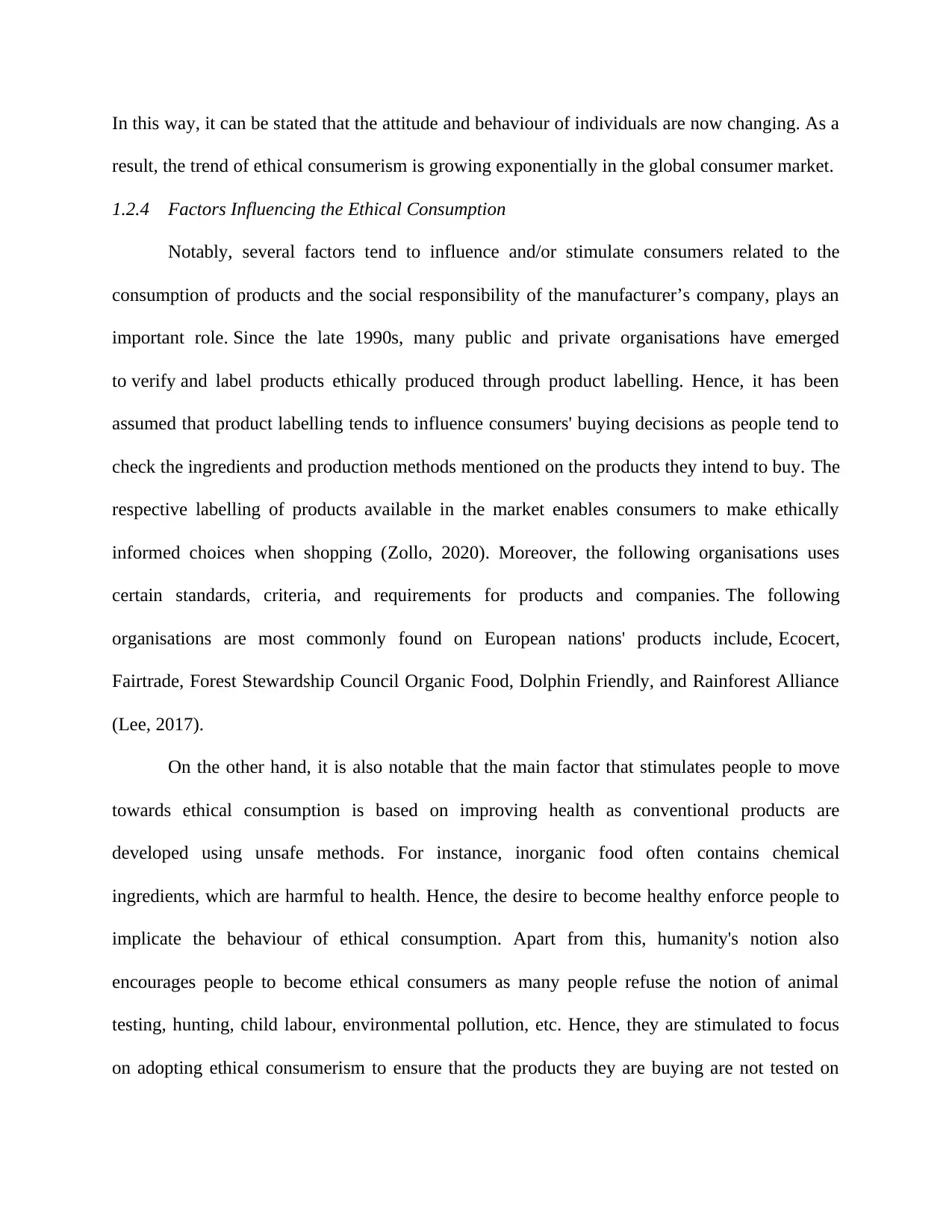
In this way, it can be stated that the attitude and behaviour of individuals are now changing. As a
result, the trend of ethical consumerism is growing exponentially in the global consumer market.
1.2.4 Factors Influencing the Ethical Consumption
Notably, several factors tend to influence and/or stimulate consumers related to the
consumption of products and the social responsibility of the manufacturer’s company, plays an
important role. Since the late 1990s, many public and private organisations have emerged
to verify and label products ethically produced through product labelling. Hence, it has been
assumed that product labelling tends to influence consumers' buying decisions as people tend to
check the ingredients and production methods mentioned on the products they intend to buy. The
respective labelling of products available in the market enables consumers to make ethically
informed choices when shopping (Zollo, 2020). Moreover, the following organisations uses
certain standards, criteria, and requirements for products and companies. The following
organisations are most commonly found on European nations' products include, Ecocert,
Fairtrade, Forest Stewardship Council Organic Food, Dolphin Friendly, and Rainforest Alliance
(Lee, 2017).
On the other hand, it is also notable that the main factor that stimulates people to move
towards ethical consumption is based on improving health as conventional products are
developed using unsafe methods. For instance, inorganic food often contains chemical
ingredients, which are harmful to health. Hence, the desire to become healthy enforce people to
implicate the behaviour of ethical consumption. Apart from this, humanity's notion also
encourages people to become ethical consumers as many people refuse the notion of animal
testing, hunting, child labour, environmental pollution, etc. Hence, they are stimulated to focus
on adopting ethical consumerism to ensure that the products they are buying are not tested on
result, the trend of ethical consumerism is growing exponentially in the global consumer market.
1.2.4 Factors Influencing the Ethical Consumption
Notably, several factors tend to influence and/or stimulate consumers related to the
consumption of products and the social responsibility of the manufacturer’s company, plays an
important role. Since the late 1990s, many public and private organisations have emerged
to verify and label products ethically produced through product labelling. Hence, it has been
assumed that product labelling tends to influence consumers' buying decisions as people tend to
check the ingredients and production methods mentioned on the products they intend to buy. The
respective labelling of products available in the market enables consumers to make ethically
informed choices when shopping (Zollo, 2020). Moreover, the following organisations uses
certain standards, criteria, and requirements for products and companies. The following
organisations are most commonly found on European nations' products include, Ecocert,
Fairtrade, Forest Stewardship Council Organic Food, Dolphin Friendly, and Rainforest Alliance
(Lee, 2017).
On the other hand, it is also notable that the main factor that stimulates people to move
towards ethical consumption is based on improving health as conventional products are
developed using unsafe methods. For instance, inorganic food often contains chemical
ingredients, which are harmful to health. Hence, the desire to become healthy enforce people to
implicate the behaviour of ethical consumption. Apart from this, humanity's notion also
encourages people to become ethical consumers as many people refuse the notion of animal
testing, hunting, child labour, environmental pollution, etc. Hence, they are stimulated to focus
on adopting ethical consumerism to ensure that the products they are buying are not tested on
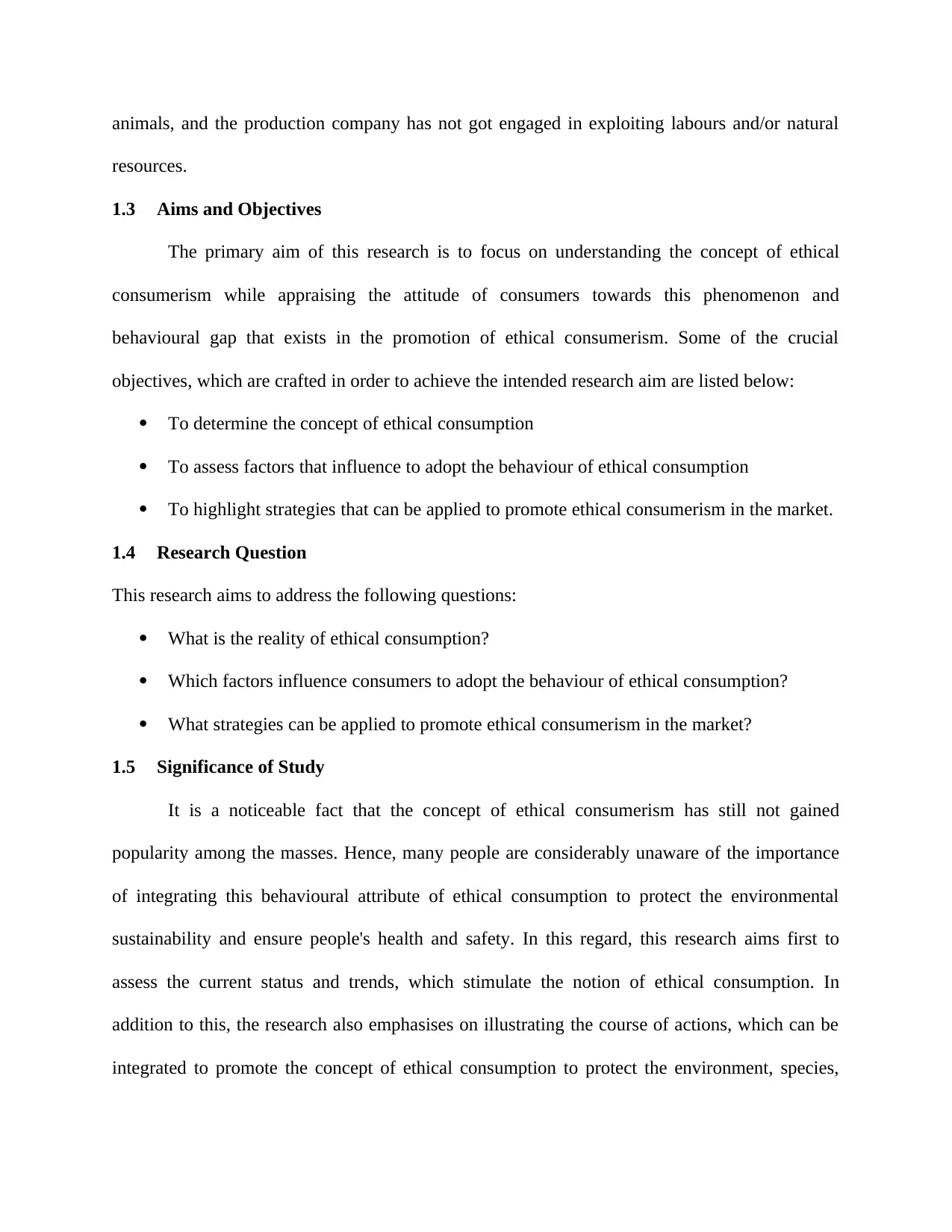
animals, and the production company has not got engaged in exploiting labours and/or natural
resources.
1.3 Aims and Objectives
The primary aim of this research is to focus on understanding the concept of ethical
consumerism while appraising the attitude of consumers towards this phenomenon and
behavioural gap that exists in the promotion of ethical consumerism. Some of the crucial
objectives, which are crafted in order to achieve the intended research aim are listed below:
To determine the concept of ethical consumption
To assess factors that influence to adopt the behaviour of ethical consumption
To highlight strategies that can be applied to promote ethical consumerism in the market.
1.4 Research Question
This research aims to address the following questions:
What is the reality of ethical consumption?
Which factors influence consumers to adopt the behaviour of ethical consumption?
What strategies can be applied to promote ethical consumerism in the market?
1.5 Significance of Study
It is a noticeable fact that the concept of ethical consumerism has still not gained
popularity among the masses. Hence, many people are considerably unaware of the importance
of integrating this behavioural attribute of ethical consumption to protect the environmental
sustainability and ensure people's health and safety. In this regard, this research aims first to
assess the current status and trends, which stimulate the notion of ethical consumption. In
addition to this, the research also emphasises on illustrating the course of actions, which can be
integrated to promote the concept of ethical consumption to protect the environment, species,
resources.
1.3 Aims and Objectives
The primary aim of this research is to focus on understanding the concept of ethical
consumerism while appraising the attitude of consumers towards this phenomenon and
behavioural gap that exists in the promotion of ethical consumerism. Some of the crucial
objectives, which are crafted in order to achieve the intended research aim are listed below:
To determine the concept of ethical consumption
To assess factors that influence to adopt the behaviour of ethical consumption
To highlight strategies that can be applied to promote ethical consumerism in the market.
1.4 Research Question
This research aims to address the following questions:
What is the reality of ethical consumption?
Which factors influence consumers to adopt the behaviour of ethical consumption?
What strategies can be applied to promote ethical consumerism in the market?
1.5 Significance of Study
It is a noticeable fact that the concept of ethical consumerism has still not gained
popularity among the masses. Hence, many people are considerably unaware of the importance
of integrating this behavioural attribute of ethical consumption to protect the environmental
sustainability and ensure people's health and safety. In this regard, this research aims first to
assess the current status and trends, which stimulate the notion of ethical consumption. In
addition to this, the research also emphasises on illustrating the course of actions, which can be
integrated to promote the concept of ethical consumption to protect the environment, species,
⊘ This is a preview!⊘
Do you want full access?
Subscribe today to unlock all pages.

Trusted by 1+ million students worldwide
1 out of 75
Related Documents
Your All-in-One AI-Powered Toolkit for Academic Success.
+13062052269
info@desklib.com
Available 24*7 on WhatsApp / Email
![[object Object]](/_next/static/media/star-bottom.7253800d.svg)
Unlock your academic potential
Copyright © 2020–2025 A2Z Services. All Rights Reserved. Developed and managed by ZUCOL.





